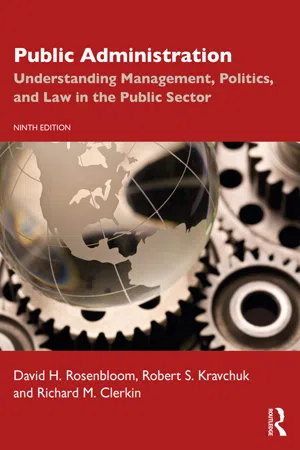
Public Administration
Understanding Management, Politics, and Law in the Public Sector
- 480 pages
- English
- ePUB (mobile friendly)
- Available on iOS & Android
Public Administration
Understanding Management, Politics, and Law in the Public Sector
About this book
The ninth edition of Public Administration: Understanding Management, Politics, and Law in the Public Sector grounds students in the fundamentals of public administration while embracing its complexity. It describes, explains, and analyzes public administration through the lenses of three well-established perspectives: management, politics, and law. In addition to thoroughly refreshed examples and case studies, significant updates to this new edition include the following:
- The discussion of management has been collapsed into a single category, contemporary public management, to better reflect the blending of traditional/orthodox and new public management approaches in the field.
- Significant changes to federal administration initiated by the Trump administration, the emergence of "hyper-" partisanship, major court decisions affecting public administration, and newer scholarship and foci in public administration.
- A thoroughly rewritten chapter on budgeting and public finance.
- New public governance material is incorporated throughout the book, including collaborative models for coordinating administration with private organizations, particularly nonprofits.
- Additional attention is paid to public participation in public administration, including public administration's potential contribution to strengthening democratic citizenship.
- Thorough discussion of the latest managerial techniques and concepts as well as the contemporary performance orientation in the public sector.
- Downloadable instructor support materials including Key Points, Discussion and/or Test Questions, Multiple Choice Questions, True or False Questions, and an Answer Key to accompany each chapter in the book.
Together these revisions reinvigorate the book yet retain its core structure, ideas, and familiarity for students and instructors alike. While the new edition retains its focus on the U.S. context, the focus on managerial, legislative, and judicial functions lends itself well to public administration in many developed nations, making the book a popular choice with instructors around the globe. This time-tested and fully up-to-date textbook is required reading for all students of public administration, public management, and nonprofit management.
Frequently asked questions
- Essential is ideal for learners and professionals who enjoy exploring a wide range of subjects. Access the Essential Library with 800,000+ trusted titles and best-sellers across business, personal growth, and the humanities. Includes unlimited reading time and Standard Read Aloud voice.
- Complete: Perfect for advanced learners and researchers needing full, unrestricted access. Unlock 1.4M+ books across hundreds of subjects, including academic and specialized titles. The Complete Plan also includes advanced features like Premium Read Aloud and Research Assistant.
Please note we cannot support devices running on iOS 13 and Android 7 or earlier. Learn more about using the app.
Information
Part IIntroduction: Definitions, Concepts, and Settings
- Chapter 1 The Contemporary Practice and Discipline of Public Administration: Managerial, Political and Policy, and Legal Perspectives
- Chapter 2 The American Administrative State: Development and Political Environment
- Chapter 3 Federalism and Intergovernmental Relations: The Structure of the American Administrative State
Chapter 1The Contemporary Practice and Discipline of Public Administration: Managerial, Political and Policy, and Legal Perspectives
KEY LEARNING OBJECTIVES
- Be able to define public administration, and to identify its principal concerns.
- Understand the differences between public administration and private management.
- Learn the managerial, political and policy, and legal approaches to public administration and the tensions among them.
- Learn how new public governance (NPG) seeks to reform public administration.
Some Definitions
- “Public administration … is the action part of government, the means by which the purposes and goals of government are realized.”
- “Public administration as a field is mainly concerned with the means for implementing political values.”
- “Public administration can be best identified with the executive branch of government.”
- “The process of public administration consists of the actions involved in effecting the intent or desire of a government. It is thus the continuously active, ‘business’ part of government, concerned with carrying out the law, as made by legislative bodies (or other authoritative agents) and interpreted by the courts, through the processes of organization and management.”
- Public administration (a) is a cooperative group effort in a public setting; (b) covers all three branches—executive, legislative, and judicial—and their interrelationships; (c) has an important role in the formulation of public policy, and is thus part of the political process; (d) is different in significant ways from private administration; and (e) is closely associated with numerous private groups and individuals.
Emphasizing the Public in Public Administration
Constitutions
Table of contents
- Cover
- Endorsement Page
- Half-Title Page
- Title Page
- Copyright Page
- Contents in Brief
- Table of Contents
- Preface
- Part I Introduction: Definitions, Concepts, and Settings
- Part II Core Functions
- Part III The Convergence of Management, Politics and Policy, and Law in the Public Sector
- Part IV Public Administration and the Public
- Glossary
- Index